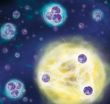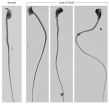(Press-News.org) Children delivered by cesarean section and those given antibiotics during early infancy appear more prone to developing allergic inflammation of the esophagus — the muscular tube that connects the mouth to the stomach — according to results of a study by investigators from the Johns Hopkins Children's Center and Harvard Medical School.
The findings, published online May 2 in the Journal of Allergy and Clinical Immunology: In Practice, reveal that early antibiotic treatment and C-section delivery may somehow precipitate disease development by altering a child's microbiota — the trillions of bacteria and other organisms residing in human intestines that regulate digestive health and immunity.
Eosinophilic esophagitis, or EoE, is an emerging allergic disease, the causes of which remain unclear. While still relatively rare, EoE appears to be on the rise in both children and adults, research shows. The condition is marked by irritation, inflammation and constriction of the esophagus and by proliferation of eosinophils, or immune cells that multiply during allergic reactions. Because EoE's cardinal symptoms — heartburn, swallowing difficulties and persistent burping — mimic garden-variety gastritis, biopsy of the esophagus remains the only definitive way to distinguish between the two disorders.
"It is becoming increasingly clear that the early development and composition of our gut bacteria can influence immunity for life," says study lead investigator Corinne Keet, M.D., Ph.D., a pediatric allergist at the Johns Hopkins Children's Center. "Now, our findings suggest that delivery via C-section and early treatment with antibiotics also play an important role in this serious allergic disease."
Although more research is needed to understand the precise mechanism by which C-section birth and antibiotics lead to EoE, the researchers suspect these two factors precipitate serious shifts in the composition of a baby's developing gut. Babies born via vaginal delivery are exposed to certain maternal bacteria as they pass through the birth canal. Those bacteria colonize the newborn's gut and help build immunity. Children born via C-section, however, miss out on this vital initial exposure to bacteria, the researchers say, which may render their immune systems more sensitive to food and other generally harmless substances.
Also, during the first year of life, the gut microbiome undergoes dramatic changes as the infant encounters various microorganisms in the environment. Antibiotics during this critical period may alter gut immunity because the drugs tend to cause collateral damage by wiping out "healthy" bacteria along with disease-causing ones, the team notes, which can lead to an imbalance between good and bad bacteria in the gut.
The researchers analyzed the medical records and upper endoscopy test results of 99 children, ages 1 through 5, one fourth of whom had been diagnosed with EoE. In addition, the investigators collected information from parents about the children's symptoms and behavior.
The rate of EoE was three times higher among children born via C-section, compared with those delivered vaginally. EoE rates were 3.5 times higher among those treated with antibiotics in the first year of life. Breastfeeding did not make a difference in EoE risk, the study found, nor did the age at which a baby started eating solid foods.
"Our findings are yet another reminder to be vigilant against unnecessary antibiotic use, but particularly so in the first year of life because infants are extra sensitive to the effects of these drugs and can suffer lifelong consequences to immunity and digestive health," Keet says.
In addition, Keet says, the link between C-sections and EoE raises important questions about finding alternative ways to introduce these good maternal bacteria into a newborn's system if vaginal delivery is not possible.
INFORMATION:
The work was funded by the National Institute of Allergy and Infectious Diseases under grant 1K23AI103187-01. Additional support was provided by the Demarest Lloyd Jr. Foundation.
Birth by C-section, early antibiotic use put kids at risk for allergic esophagitis
2014-05-13
ELSE PRESS RELEASES FROM THIS DATE:
Professional surfer back in the water after successful surgery to treat rare bone cancer
2014-05-13
LOS ANGELES (May 13, 2014) – When professional surfer Richie Lovett began experiencing hip pain at 31, he attributed it to his athletic lifestyle. But after months of discomfort and preliminary tests, the Australian native learned the pain was caused by a cancerous tumor in his femur or thigh bone.
"As a professional athlete, I was blindsided by the news that I had cancer," said Lovett. "I realized very quickly that cancer would have a profound effect on my life. I knew I needed an experienced oncologist to tackle this disease, so I began an international search to find ...
Quantum trimer -- from a distance
2014-05-13
Eight years ago Rudolf Grimm's research group was the first to observe an Efimov state in an ultracold quantum gas. The Russian physicist Vitali Efimov theoretically predicted this exotic bound state of three particles in the 1970s. He forecast that three particles would form a bound state due to their quantum mechanical properties, under conditions when a two-body bound state would be absent. What is even more astounding: When the distance between the particles is increased by factor 22.7, another Efimov state appears, leading to an infinite series of these states. Until ...
Researchers identify link between colon cancer and metabolism
2014-05-13
HEIDELBERG, 13 May 2014 – More than 60 years ago Otto Warburg recognized that cancer cells differ from normal cells in the metabolic pathway they use for the oxidation of sugar. Rather than the typical series of oxidative steps that take place in the citric acid cycle, cancer cells metabolize sugar via the glycolytic pathway irrespective of whether oxygen is present or not. In The EMBO Journal, researchers in the United States report that the reason for this difference in colon cancer is changes in the Wnt signaling pathway, an essential communication pathway operating ...
Dangerous nitrogen pollution could be halved
2014-05-13
Ambitious mitigation efforts, however, could decrease the pollution by 50 percent. The analysis is the very first to quantify this.
"Nitrogen is an irreplaceable nutrient and a true life-saver as it helps agriculture to feed a growing world population – but it is unfortunately also a dangerous pollutant," says Benjamin Bodirsky, lead-author of the study. In the different forms it can take through chemical reactions, it massively contributes to respirable dust, leads to the formation of aggressive ground-level ozone, and destabilizes water ecosystems. Damages in Europe ...
Male infertility: It's all about the package
2014-05-13
Cold Spring Harbor, NY – Infertility is generally thought of as a woman's problem. In fact, more than 3 million men across America also experience it. Today, researchers from Cold Spring Harbor Laboratory (CSHL) describe a key event during sperm development that is essential for male fertility. A team led by CSHL Professor Alea Mills explains how a protein controls DNA packaging to protect a man's genetic information.
The sperm is a simple delivery vehicle for a man's genetic information. The highly specialized cell is little more than a DNA bundle powered by molecular ...
Concerns raised over EU ban on ditching unwanted fish
2014-05-13
New rules banning fishermen from throwing away unwanted fish they have caught could harm wildlife – and fail to improve fish stocks, a University of Strathclyde report has found.
The study, published in the journal Nature Communications, suggests new reforms to the European Union's Common Fisheries Policy (CFP) – ending the practice of throwing away unwanted fish caught at sea – may have unintended consequences. The new CFP took effect on 1 January 2014 and will phase out the discarding of fish between 2015 and 2019.
The aim is to improve fish stocks – but Professor ...
Researchers identify genetic marker linked to OCD
2014-05-13
A group of researchers led by Johns Hopkins scientists say they have identified a genetic marker that may be associated with the development of obsessive-compulsive disorder (OCD), whose causes and mechanisms are among the least understood among mental illnesses.
The results of the research are published online May 13 by the journal Molecular Psychiatry.
"If this finding is confirmed, it could be useful," says study leader Gerald Nestadt, M.D., M.P.H., a professor of psychiatry and behavioral sciences at the Johns Hopkins University School of Medicine and director of ...
Humans and companion animals harbor the same types of MRSA infections
2014-05-13
A shared population of methicillin-resistant Staphylococcus aureus (MRSA) bacteria circulates both in humans and companion animals, according to a study published this week in mBio®, the online open-access journal of the American Society for Microbiology.
"Our study demonstrates that humans and companion animals readily exchange and share MRSA bacteria from the same population," says senior author Mark Holmes, senior lecturer in preventive veterinary medicine at the University of Cambridge in England. MRSA naturally lives on the skin and also causes difficult-to-treat ...
E-cigarettes and mental health
2014-05-13
Researchers at University of California, San Diego School of Medicine report that people living with depression, anxiety or other mental health conditions are twice as likely to have tried e-cigarettes and three times as likely to be current users of the controversial battery-powered nicotine-delivery devices, as people without mental health disorders.
They are also more susceptible to trying e-cigarettes in the future in the belief that doing so will help them quit, the scientists said. The FDA has not approved e-cigarettes as a smoking cessation aid.
The study will ...
Novel target found for chemotherapy-resistant leukemia cells
2014-05-13
Researchers at Children's Hospital Los Angeles have discovered that by targeting a particular receptor, chemotherapy-resistant cancer cells can be killed in an acute form of childhood leukemia, offering the potential for a future treatment for patients who would otherwise experience relapse of their disease.
Nora Heisterkamp, PhD, and colleagues at The Saban Research Institute of Children's Hospital Los Angeles have discovered that by targeting the B-cell activating receptor (BAFF-R), chemotherapy-resistant precursor B acute lymphoblastic leukemia cells (pre-B ALL) can ...



